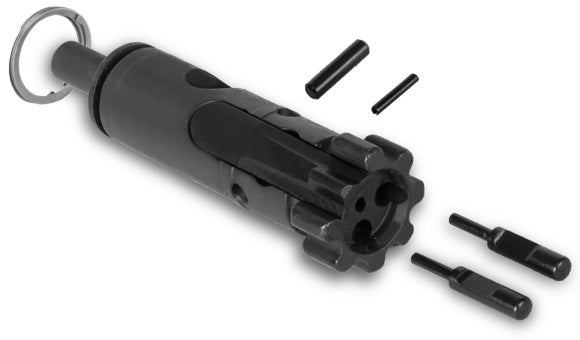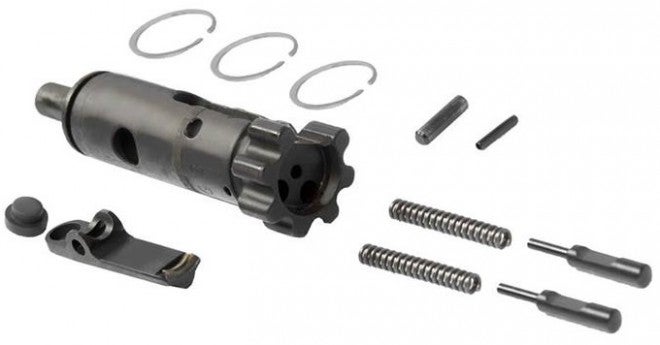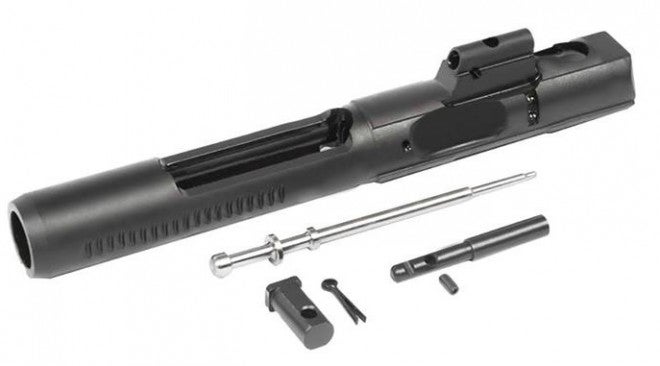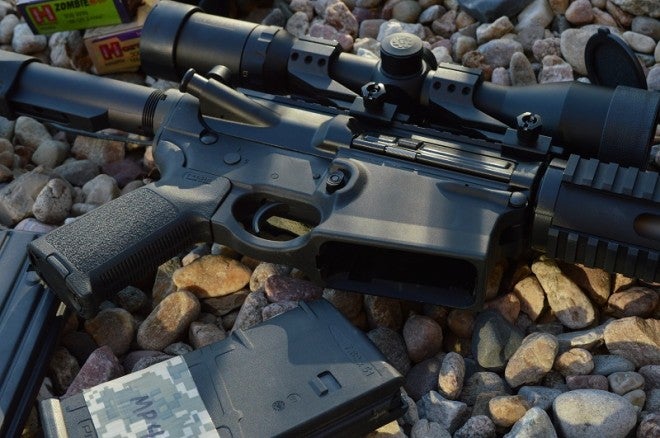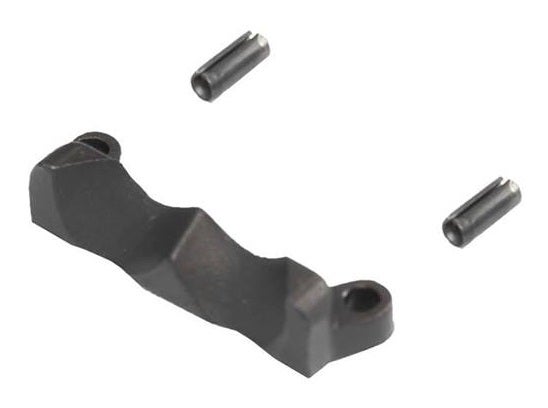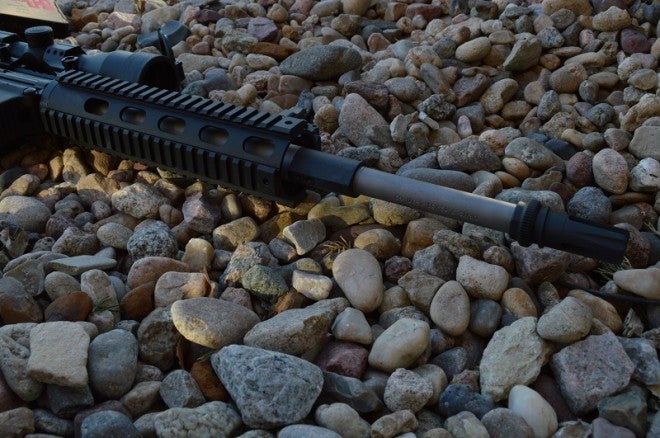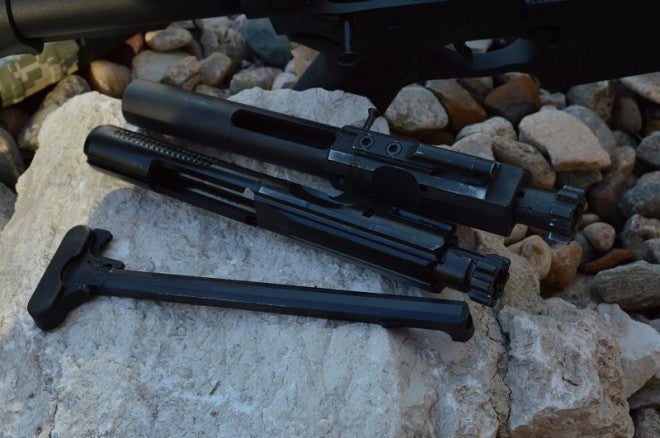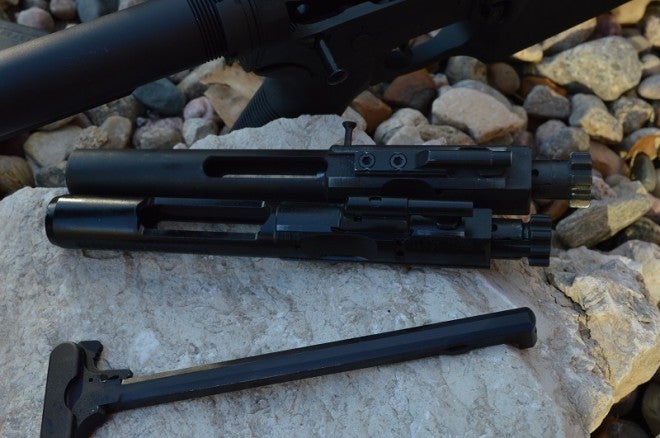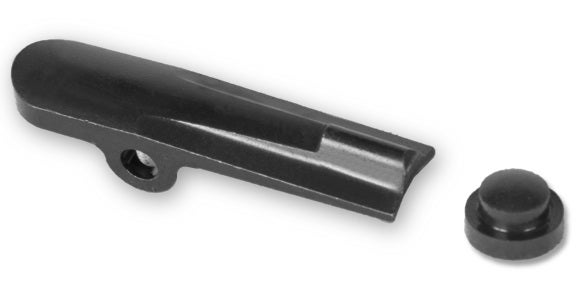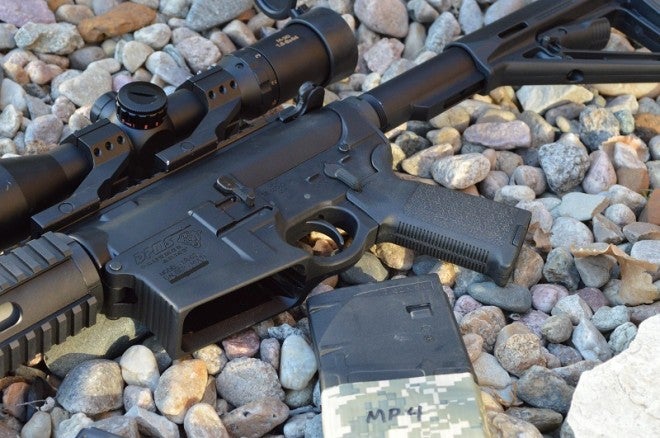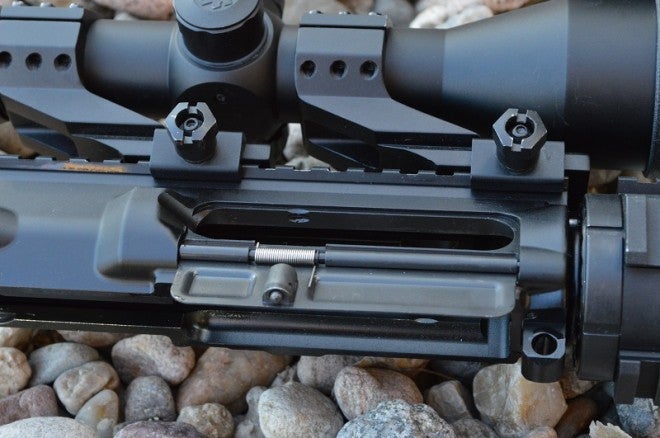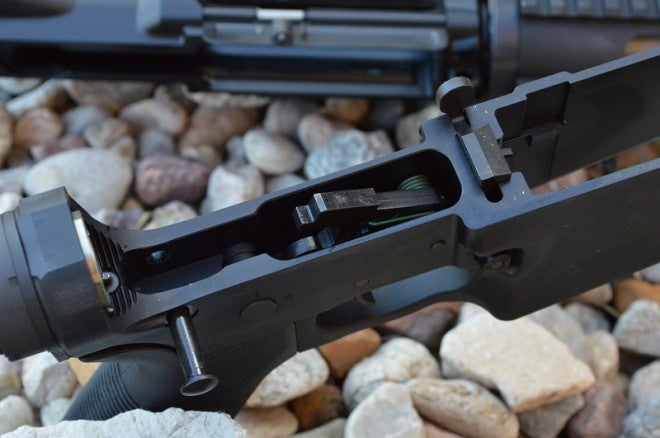Review: DPMS GII Recon 308 AR-Style Rifle
Major Pandemic 10.11.16
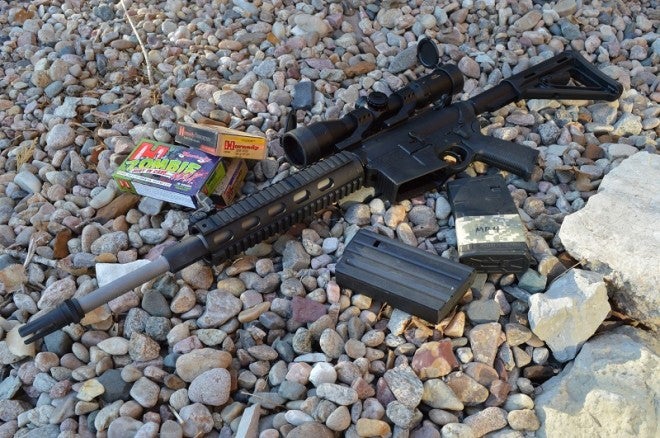
Oddly, I find myself back where I began my AR-platform adventure: with a 308 DPMS. But this DPMS rifle has changed drastically. My first AR was a 308B, which was accurate but heavier. Later I had a much lighter 308 AP4, and in January I was excited to see that DPMS had introduced the Recon model, which seemed the perfect compromise between my old AP4 and 308B.
Why Did DPMS Create Another 308 AR Format?
Unlike the AR15 format, there is no “standard” or “mil-spec” for the 308 AR format, and thus we see several variations that are not compatible with one another. There are magazine and barrel nut differences between Armalite and DPMS 308 rifles. In some cases, hand guards and other parts are incompatible, which means the selection of aftermarket parts can be a pain.
The DPMS format has become the most popular 308 AR platform, thanks in part to Magpul LR20 308 magazines. Armalite’s AR10 platform also continues to be popular, but due to rifle and accessory availability and price, the DPMS format continues to reign.
DPMS decided to take a chance on something completely new that could change the AR 308 world, and that became the DPMS GII 308 platform. The GII is a completely different 308 format from the ground up. The GII is lighter, more dependable, smaller, more ergonomic, and more compatible with AR15 accessories than any other 308 AR platform. These are not their words. These are mine.
At the SHOT Show, I had a chance to speak with DPMS Project Manager Adam Ballard. Adam was key in driving the design and development of the the GII and was the first to ask the question, “If the scaled-down AR15 design from the original Stoner design works, why do we need to scale back up so much just to have a 308?”
As you may know, the AR10 was Stoner’s first AR-platform rifle, and it was later scaled down to the AR15 format, but Adam’s question was basically this: “Can we build a 308 around an AR15 5.56 NATO sized chassis?” The result was an all-new design that drops everything other than the magazine from the original DPMS GI design.
Lighter
By starting with AR15-sized upper and lower receivers extended only enough to allow clearance for the larger magazine, DPMS was immediately able to drop weight and provide a much more compact rifle. Making the carrier the same diameter as an AR15 also significantly reduced weight.
I will note that DPMS claims “30% lighter than the original” on their marketing materials, but in reality, I think they meant to say “The receiver assembly is 30% lighter.” The old DPMS Recon was 8.95 lbs and the new GII DPMS Recon is 8.5 lbs, which is actually only a 5% reduction, but that is a substantial .45-lb weight reduction, which almost entirely occurs within the receiver assembly. Drop in a carbon fiber forend and Ace Skeleton stock and I bet you could get that weigh hovering just over 8 pounds.
More Dependable
Over the years, I have become somewhat of a DPMS 308 mechanic, having fixed dozens of them for my friends. The original DPMS Gen 1 mags created horrible feeding, functioning, and jams. If it had not been for DPMS customer service swapping out old mags for new uber-dependable Magpul LR20 mags, I fear that first 308B would have been my last.
A dealer once sold me a used DPMS AP4 for around $500 as non-operational due to its chronic jamming problems. That AP4 needed the ejector spring replaced, and when I fed it via Magpul LR20 mags, I had a perfectly working DPMS AP4 308.
DPMS has made a ton of engineered improvements based on customer feedback, which are evident in the GII models. To slick things up a bit more, DPMS coats the 7075 forged receivers with Teflon to improve reliability, cleaning, speed, and smooth functioning.
The GII features dual ejectors, which are lighter-sprung than before. They are so well-tuned that while bench testing the DPMS Recon GII, I could drop the majority of ejected brass into a 5-gallon bucket sitting just a few feet from the bench.
The new GII has a smaller-diameter and shorter carrier, similar in size to an AR15 carrier. A lighter carrier means less parts fatigue, less reciprocating weight to manage during recoil, and a more pleasant shooting experience.
A new elastomer extractor button replaces the extractor spring and is designed to last exponentially longer than the old version while increasing extraction reliability.
The GII Line has a longer ejection port than the GI had, which is a good thing.
Surprisingly, DPMS indicated the older GI models had issues with gas keys coming loose. I never experienced this with dozens of them that passed through my hands. DPMS permanently solved the issue by creating a monolithic bolt carrier that unified the carrier and gas key into one part.
I have never had an issue with feed ramp wear, but DPMS perceived there was a problem due to customer feedback at the military level. Their solution on the GII was to use steel feed ramps.
More Ergonomic
A shorter, more compact, lighter format is generally less fatiguing, and the DPMS GII format delivers just that with a package that feels like an AR15. The GII receiver is just ½” longer than an AR15 receiver and ⅝” shorter than the old GI 308 receivers. It may not sound like a lot, but once in the hands the Recon GII feels like a AR15 instead of a 308.
Other nice touches include not having to chase brass as far, a larger finger space inside the integrated trigger guard, a lighter rifle, and a beveled and flared mag well to improve reload speeds.
Greater Capability for Accessorizing
From the mag well back, the GII can accept all AR15 accessories and parts with the exception of the buffer and buffer spring so all your grips, stocks, receiver pins, triggers, and selectors can be AR15 spec parts.
The receiver is AR15-spec height, which means AR15 handguards can fit on this rifle, but a DPMS AP4 GII barrel nut is required for use with aftermarket AR15 handguards, which require AR15-spec barrel nuts.
DPMS GII Recon 308
The DPMS 16” barreled GII Recon weights less, is more dependable, and is far easier to handle and faster to shoot than any other DPMS 308. In short, I like it a lot.
The Recon was originally intended as an all-purpose rifle that could serve for defense, large-bore 3 Gun, or North American large game hunting all in one package.
I slipped on a new Konus Pro M30 1.5x6x 44mm illuminated scope and had everything I need for hunting and defense work. It features a standard plex reticle, which can provide accurate 400-yard shots with practice and an understanding of holdovers. This scope packs a lot of features into a $250 street priced optic: excellent clarity, a wide usable magnification range, etched recoil-proof reticle, large light-gathering 30mm tube, and blue reticle dot illumination.
GII Recon Features
Beyond the base GII features shared by entire line, the Recon features a 16” 426 stainless barrel with a mid-length gas system to soften recoil with a DPMS low-profile gas block. The Recon’s heavy H-Bar style barrel is sized somewhere between a bull barrel and lightweight M4 profile. This provides enough weight to allow surprisingly good accuracy while being light enough to actually carry on a hunt.
Though I am not a huge fan of quad rails, it fits with the defensive capabilities of the rifle and the free float DPMS quad-rail hand guard is durable and offers plenty of rail space to hang your tactical lights, lasers, and whatnot.
Other features include the Magpul MOE pistol grip, 6-position adjustable stock, Advanced Armament 51T Blackout silencer-adapter flash hider, and Magpul flip up sights. Of special note is the excellent 2-stage DPMS trigger, which is one of the best non-custom factory AR triggers I have used.
Function and Accuracy
Each of the five DPMS 308s I have owned required a bit of break-in time to deliver reliable operation (and they still dislike cheap ammo). In the case of the GII, that break-in process ended with the first round when using quality ammo.
The GII’s reliability improvements were obvious when I sent the first 50 rounds downrange without a hiccup or bobble even with the factory steel DPMS mags. Magpul LR20 magazines delivered the same flawless reliability I have come to expect. Ejected brass was not being thrown 20 feet, but just a few feet with such reliability that most dropped into a 5-gallon bucket. Thank you, DPMS.
As expected, the 16” barrel with prong flash hider is loud as hell, but I am sure we could make it even louder with a muzzle brake. The recoil impulse was considerably lighter than my old AP4 and other DPMS 308 format rifles.
I will note that the cheap steel-cased Cabelas Herter’s 308 ammo gave me some problems. I have had this problem before with most DPMS Gen 1 308s, and it is my opinion this ammo was just a hint below SAAMI spec and that contributes to cycling issues. This ammo consistently failed to lock the bolt back and on rare occasion, didn’t fully cycle.
I mentioned this issue to my FFL dealer and aggravated him to no end. “Why would you take a great gun, run the cheapest ammo through it, and then bitch about reliability?” “Because I am a writer and someone will say I am full of it when they test it with cheap ammo and have issues, so I am quoting this conversation for the article.”
So take note: you may have issues with cheap steel-cased ammo, but I had no issues whatsoever with quality factory brass cased and mil-spec 7.62 NATO rounds. Even less-expensive Winchester White box and Wolf steel case functioned perfectly.
Slipping on my Nikon 8-32x Monarch Optic for accuracy testing delivered consistent 1″ 100-yard groups. With my premium Federal Gold Match, Winchester, and Hornady ammo, I could shrink those 100-yard groups down to the .75″-1″ range. Plenty accurate for a 16″ barreled 308 semi-auto rifle.
Final Thoughts
I applaud DPMS for the design innovations. Time will tell how other designs will be adapted across the industry, but based on what I’ve seen so far, it should be well-received. The rifle has superior ergonomics, less weight, a smaller size, is more fun to shoot, and retains DPMS’s magazine compatibility and excellent accuracy standards.
Manufacturer Specs
- MSRP $1759
- Model RFLR-G2REC
- CALIBER: 308 / 7.62 Nato
- LENGTH: 38”
- WEIGHT: 8.5lbs
- BARREL: 16″ 416 Stainless, Bead Blasted – Mid length Gas
- UPPER RECEIVER: Forged 7075 T6 lvl 3 Anodized, Teflon coated, A3 type
- LOWER RECEIVER: Forged 7075 T6 lvl Anodized, Teflon coated
- TWIST: 1×10
- STOCK: MagPul® MOE 6 Position Collapsible Stock
- FIRE CONTROL: DPMS 2 Stage
- PISTOL GRIP: MagPul® MOE
- FRONT / REAR SIGHT: MagPul® Front and Rear BUIS
- FLASH HIDER: None – Advanced Armament 51T Blackout Silencer Adapter
- HANDGUARD: DPMS 4 Rail Free Float Tube
See also: Modifying the DPMS GII Recon 308
